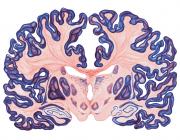Overt and covert visual search in primates: reaction times and gaze shift strategies.
Publication Year
2009
Type
Journal Article
Abstract
In order to investigate the search performance and strategies of nonhuman primates, two macaque monkeys were trained to search for a target template among differently oriented distractors in both free-gaze and fixed-gaze viewing conditions (overt and covert search). In free-gaze search, reaction times (RT) and eye movements revealed the theoretically predicted characteristics of exhaustive and self-terminating serial search, with certain exceptions that are also observed in humans. RT was linearly related to the number of fixations but not necessarily to the number of items on display. Animals scanned the scenes in a nonrandom manner spending notably more time on targets and items inspected last (just before reaction). The characteristics of free-gaze search were then compared with search performance under fixed gaze (covert search) and with the performance of four human subjects tested in similar experiments. By and large the performance characteristics of both groups were similar; monkeys were slightly faster, and humans more accurate. Both species produced shorter RT in fixed-gaze than in free-gaze search. But while RT slopes of the human subjects still showed the theoretically predicted difference between hits and rejections, slopes of the two monkeys appeared to collapse. Despite considerable priming and short-term learning when similar tests were continuously repeated, no substantial long-term training effects were seen when test conditions and set sizes were frequently varied. Altogether, the data reveal many similarities between human and monkey search behavior but indicate that search is not necessarily restricted to exclusively serial processes.
Keywords
Journal
J Integr Neurosci
Volume
8
Pages
137-74
Date Published
06/2009
ISSN Number
0219-6352
Alternate Journal
J. Integr. Neurosci.
PMID
19618485

